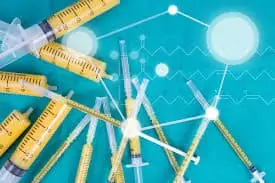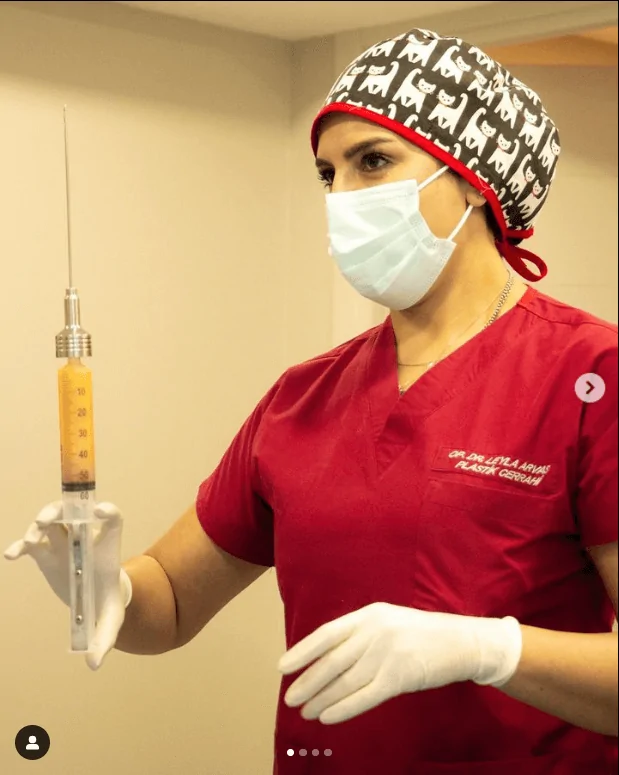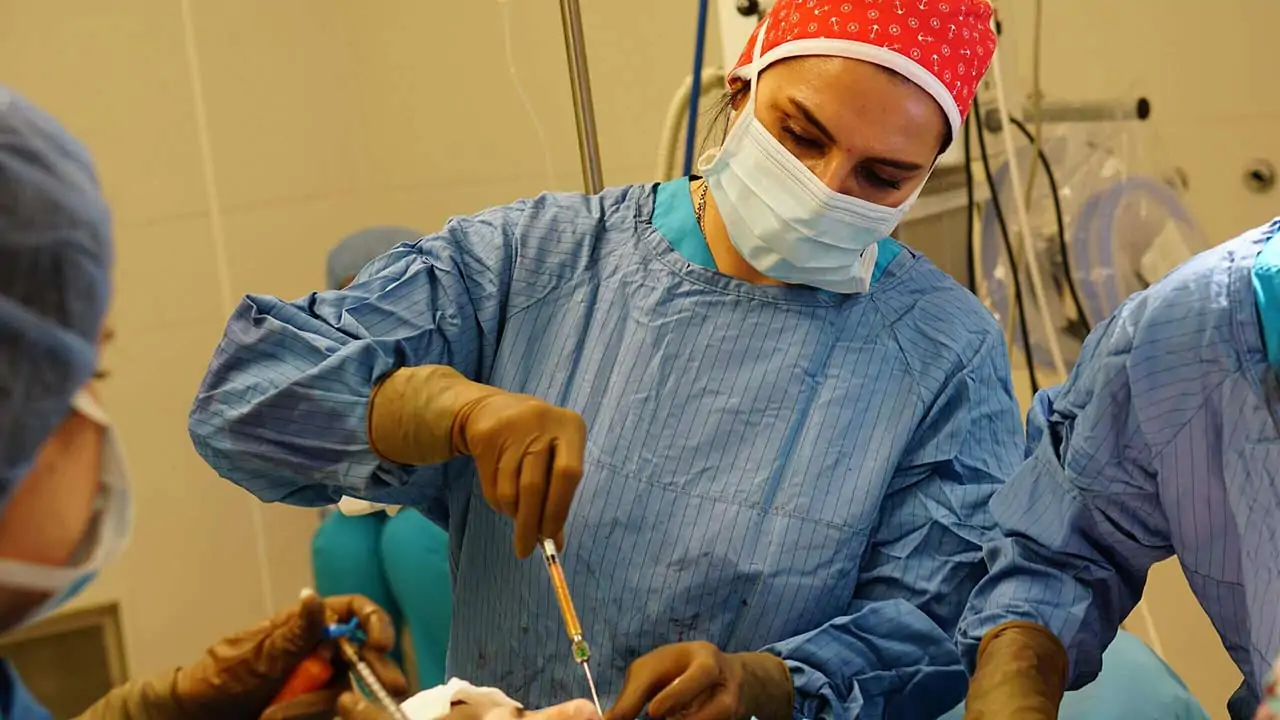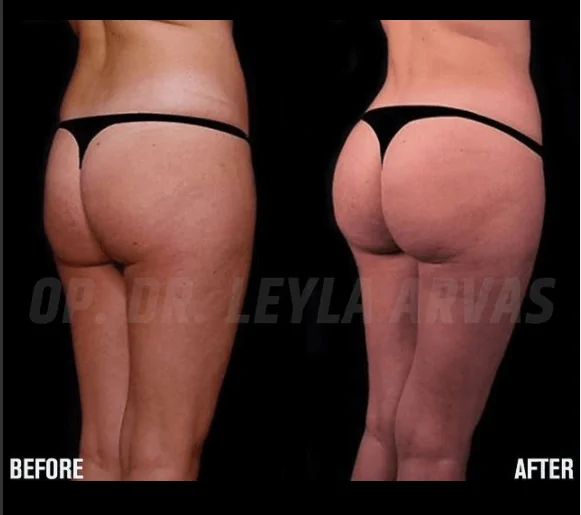What is Fat Transfer?
Fat transfer called Lipofilling (filling with fat) or fat grafting (fat transfer) is the correction of the face and body contours by transplanting the patient’s own adipose tissue from one area to another using injection.
With age, atrophic changes in soft tissues take place, which is the cause of the appearance of wrinkles and folds, the face has a tired and emaciated appearance. In such cases, injections of your own adipose tissue provide an excellent opportunity to restore lost volumes and reshaping of face.
Adipose tissue (or fat tissue) is a rich source of stem cells, which surpasses other tissues in the body in terms of their number.
Therefore, as a result of lipofilling, in addition to correcting the missing volumes, a clear improvement in the quality of tissues can be observed: the texture and color of skin become smoother, and scars are reduced. Another plus of this method is to improve not only the area of fat injection but also the area from which it was taken.
What are the Advantages of Fat Transfer?
Fat injections used for shaping the body and face bring a very natural result. Popularity of fat injection that brings natural results particularly in lips and cheeks is increasing day by day.
Results of fat injection can look perfect for years without requiring any correction. Because transferred fat is a live tissue, it will continue functioning normally in its new location.
Fat injection not only gives plumpness to the injection site, but also supports collagen production and improves the quality of skin there. For this reason, fat injection is used for treating scars as well.
Fat transfer leaves a natural feeling in your body. When you have a fat injection for augmenting your breasts or butt, you will have a soft and natural feeling. While a hard and artificial feeling is left with implants, a soft feeling as your own tissue is left in fat transfer.
Are the Results of Fat Transfer Permanent?

With the developed techniques, we can reach permanence up to 60% now.
Thanks to Vaser Liposuction, regional fats can be removed in liquid form. Fats taken out are decompounded and injected into desired areas through thin cannulas.
Thanks to the newest techniques of Vaser Liposuction, we can reach permanence between 60% and 80% now.
Permanence of fat transfer’s results also depends on the injection site. While fats melt down faster in moving areas such as legs and hips, they can stay longer in such areas as face and breasts.
With fat transfer, you can give your face plumpness and youth effect. With the effect of aging, subdermal cells reduce and a stooping face look is observed. Some people, on the other hand, have a more stooping face.
Thanks to fat injection, your face can naturally gain plumpness or you can get rid of the stooping in your face. Stooping cheeks, flat jugal bones and flat chin lines can be reshaped with fat transfer.
Wrinkles around the face and under eye drooping are also given a younger look, thanks to fat injection. Fat transfer helps your face to be plumper and your wrinkles to be less visible. You can use fat filler for augmenting thin lips as well.
Fats required for facial shaping are taken through 3-5 mm incisions. This procedure is generally used for areas with intense fat formations such as tummy, waist and hips. Aspirated fat is transferred to the desired area after centrifuge and separation processes.
For a successful fat transfer, it must be applied to the desired area through thin cannulas and in a low quantity. This way, transferred fat’s contact with the tissues around, which it needs to provide with oxygen and nutrients, is ensured.
Fat Transfer or Lipofilling (from the word lipo – fat, filling – to fill) – transplantation of the patient’s adipose tissue into his own donor area in order to correct the shape and size of the treated area. This is a low-traumatic procedure for your body.
The lipofilling procedure is performed under general anesthesia (intravenous anesthesia). In this case, the intake of fat is carried out with a special cannula and a special syringe through skin punctures about 2-3 mm in size, which guarantees quick healing without scars of surgery. Body, face and other parts of the body contour, lipofilling is a general concept that can be divided into different zones.
The Most Common Area of Fat Transfer
We can do Fat Transfer to the areas below for different purposes as:
- Fat Transfer to Breasts for a natural look
- Fat Transfer to aging Face that loses volume
- Using Fat Transfer for buttock augmentation (BBL)
- Lipofilling of the abdomen area for reshaping
- Aesthetic correction of age-related changes in the hands
- Smoothing irregularities after liposuction
- Hourglass figure with Fat Transfer
- İmprovement of the contours of the legs and thighs, correction of the curvature of the legs
How is Fat Transfer Done?
Fat transfer is usually performed under local or general anesthesia. In some cases, its application under general anesthesia may be appropriate in terms of the type of operation.
For example; Filling the cheeks with fat transfer during the facelift is an operation performed under general anesthesia. The fats taken during the operation are subjected to special processes (washing and centrifugation) and transferred to a suitable injector to the area to be transferred and injected. While applying these procedures, no incision is made, so it is an application that does not leave any scars.
Steps of Fat Transfer
As an invasive procedure fat transfer can be done under general anesthesia. We can divide this procedure into 3 steps:
- Removal of the fat deposits– Our doctors make small cuts for the entrances of the cannulas to suck the fat and then they are closing the incisions with the stitches
- Preparation of Fat collection for the Transfer– Our doctors are using a special device to separate the collected fat from the blood and other fluids to make it pure. The separated and purified transferred fat has high quality and can stay in the inpatient body for a long time. That is why it is a very important stage during the Fat Transfer procedures.
- Injection of the Prepared Fat– Doctors are again making small incisions and injecting the prepared fat to the areas that are being treated. They do not close the incisions always, if needed they are closing them with stitches.
The procedure takes a few hours, depending on the treated areas. The patient may stay one night in the hospital or can go home after a few hours after the procedure, it can be decided by the doctor after the checkup.
Fat Transfer to the Face
Fat transfer application to the face is mostly preferred. The subcutaneous adipose tissue in the face area decreases and this causes the skin to lose its tension. Wrinkles and pits occur. With the process of replacing the reduced fat tissue with fat transfer, the person gets a naturally beautiful appearance.
The Areas Where Fat Transfer is Made to the Face are:
- Mimic lines between the eyebrows
- Upper lip area
- Lower lip area
- Forehead mimic lines
- Forehead area
- Temporal region (temporal region)
- Cheek area
- Under eye area
- Nasolabial region (the line from the nose to the mouth)
- Cheekbones area
How is Fat Transfer Done to The Face?
 The operation can be performed with local anesthesia. Fat transfer can only be performed under local anesthesia to areas such as the nose, lips or nasolabial lines.
The operation can be performed with local anesthesia. Fat transfer can only be performed under local anesthesia to areas such as the nose, lips or nasolabial lines.
If the whole face is to be applied, it can be done with general anesthesia depending on the patient’s condition.
For fat transfer, fat cells can usually be taken from the abdomen or areas such as the hips.
It is appropriate to wear a pressure garment to the fat removed area for 2 to 4 weeks to shape the fat area.
Fat transfer can take about 1 hour when applied to the full face, and takes up to 30 minutes if applied to a single area.
No hospitalization is required. If the fat transfer is done to the whole face or to a large area after the procedure, it is fixed with a bandage and this bandage remains for a week.
Ice should be applied for the first 3 days after the operation, work that can increase blood pressure should be avoided, painkillers and antibiotics given with a doctor’s prescription should be used regularly. All these accelerate the recovering process and provide good results.
Fat Transfer to Breasts
Fat Transfer to the breasts (or Lipofilling of the Breasts) is a procedure that contours the breasts with the local introduction of the patient’s own fat cells from the area of their excessive accumulation.
The procedure is performed to model their shape, eliminate cosmetic defects, including nipple asymmetry. One manipulation allows you to increase the size of the breasts by one size. Breast lipofilling is relatively safe, its cost and duration are determined by the amount of transplanted fat.
How is Fat Transfer to Breasts Done?
The duration of the correction and the cost of breast fat transfer are determined by the amount of fat to be removed and transplanted. At the initial stage of the procedure, general anesthesia is used. Then lipofilling begins directly:
- Donor fat cells are taken from those parts of the body where there is an excess of them. Preference is often given to the outer thigh, which lacks fibrous adhesions. The surgeon makes several punctures to extract the fat.
- The collected fat is cleaned of impurities, blood, fluids and other homogenized with the elimination of seals.
- Our doctors transplant the resulting homogeneous fat mixture into the mammary glands using injections. Small portions of biomaterial are introduced so that the breast acquires a beautiful shape.
- At the final stage, the operating field is treated with antiseptics and closed with a sterile dressing material.
Who can Have Breast Enlargement with Fat Transfer?
Fat transfer to breasts is a modern, gentle way of correcting their shape and size with a high aesthetic result. Breast augmentation with fat taken from problem areas is indicated for patients in the following cases:
- Unsatisfactory bust size;
- The presence of aesthetic defects;
- A visible difference in the shape and/or size of the breasts;
- Worsening of the form after breastfeeding;
- Slight deformity as a result of previous surgery;
- The desire to increase the size without installing implants.
Lipofilling is also performed to eliminate the consequences of mastectomy – a surgical operation to remove the breast.
Who can not Have Fat Transfer to Breast?
Breast fat transfer cannot be performed if there are such absolute contraindications as:
- Arterial hypertension;
- Malignant neoplasms;
- Immunodeficiency states, autoimmune pathologies;
- Diseases of the thyroid gland;
- Acute infections;
- Insufficient supply of adipose tissue;
- Disorders of hematopoiesis, pathological blood clotting;
- Severe diseases of the cardiovascular apparatus;
- Pregnancy, breastfeeding.
Surgeons strongly recommend not to enlarge the breasts in this way if a woman plans to subsequently drastically lose weight. Relapses of chronic pathologies act as relative limitations. Outside of exacerbation, the operation can be performed.
Preparation for Breast Fat Transfer
 The preparatory phase is an important part of any surgical procedure. The patient should follow all medical recommendations to minimize the likelihood of complications.
The preparatory phase is an important part of any surgical procedure. The patient should follow all medical recommendations to minimize the likelihood of complications.
Proper preparation for the procedure is a guarantee of a quick and complete recovery.
The anesthesiologist selects a drug for high-quality pain relief, focusing on the data of a number of laboratory tests.
They allow you to timely identify the patient’s hypersensitivity to a certain chemical substance.
If an individual intolerance is found, a safe pharmacological preparation with another active ingredient will be used. Since the operation uses its own fat and not synthetic materials, special preparation is not required for it.
Instrumental and laboratory diagnostic tests are performed to exclude contraindications.
About a month before the planned intervention, the surgeon recommends making adjustments to the usual way of life:
- Reduce alcohol
- Reduce the number of cigarettes smoked as much as possible;
- Treat infections to achieve a stable remission of chronic diseases.
You should tell your doctor about all the drugs you use. Analgesics, antipyretics, acetylsalicylic acid and other anticoagulants should be discontinued.
Rehabilitation After Breast Lipofilling
- As with any surgical intervention, antibiotic therapy is indicated for the patient after fat transfer. Taking antibiotics allows you to avoid the development of an infectious process, fraught with suppuration.
- Wearing a postoperative pressure garment for several weeks helps to prevent the encapsulation of fatty tissues and their displacement. The following activities are also required:
- Maintaining body weight at the same level;
- Sleeping on your back;
- Lack of sudden movements, even moderate physical exertion;
- A balanced diet with a high content of protein foods.
- For six months, you cannot sunbathe, visit baths and saunas, and engage in active sports.
Possible complications after Breast Fat Injection
Since the procedure is less traumatic, the cause of complications is usually non-compliance with the rules of asepsis during rehabilitation, less often – the lack of experience with the doctor. This is manifested as follows:
- Accumulation of fat in one area, tuberosity;
- Inflammation of puncture sites;
- Encapsulation of fat cells;
- Loss of nipple sensitivity;
- Asymmetry of the mammary glands.
If any complication is found, medical attention is required.
Breast Fat Transfer Results
The results are immediately visible. Due to the even distribution of fat, the breast looks absolutely natural, symmetrical. It is tightened, elastic to the touch, there are no postoperative marks on the skin – scars or any scars and pronounced redness.
At the same time, breast sensitivity and the ability to lactate are preserved. The operation is so low-traumatic that a woman can be discharged from the clinic even a few hours later.
Another bonus of this correction method should be mentioned. After taking your own fat, the size of the problem area decreases. So in addition to lipofilling, a kind of liposuction is also performed – a cosmetic operation to remove fatty deposits by liposuction.
Fat Transfer to Nose
Fat transfer in the nose is applied not to shape but to give volume. This is a very important point to pay attention to. Fat transfer can be applied to people who have had previous surgery but have various irregularities on the nose.
Fat Injection of Hands
This innovative, low-traumatic procedure is the subcutaneous fat injection of the patient’s own fat into places where there is a lack of it. This method is used for various parts of the body: to correct the arms, face (including lips), sunken skin areas (caused by liposuction or scars), as well as breast and buttocks (enlargement).
Hands most often give away our age. Unfortunately, the skin on the hands becomes thinner over the years, wrinkles, age spots appear and veins appear sharply.
In such cases, even the best and magic cream will not help. Lipofilling of the hands is practically the only technique that allows you to replenish the volume of subcutaneous fat and hide the contouring tendons and blood vessels, i.e. rejuvenate the brushes and phalanges of the fingers, give the skin tone and elasticity, eliminate wrinkles and reduce age spots.
Fat Transfer to Buttocks
 Buttock fat injection is a gentle operation to correct and increase the “fifth point” due to transplantation (autotransplantation) of one’s own adipose tissue.
Buttock fat injection is a gentle operation to correct and increase the “fifth point” due to transplantation (autotransplantation) of one’s own adipose tissue.
Many girls want to enlarge or reshape their buttocks through exercise and diet. Unfortunately, the gluteal region is not always amenable to correction.
The ideal solution is fat injection to the buttocks, which is popular today in the world called BBL.
Adipose tissue for the operation is taken from problem areas of the “depot”. These are “fat traps” on the body, from which fat does not go well – the belly, lower back, inner and outer thighs. An important nuance for successful liposculpture is a sufficient amount of body fat.
Fat Transfer to the Abdominal Area
The Fat Transfer to the Abdomen area can be used while lipo modeling the abdominal areas to obtain a more muscular abdomen. It is called high definition surgery between the men.
Most male patients require this procedure. Our doctors can achieve extremely attractive results with the Fat Transfer to the abdominal area, also our doctors maintain symmetry in the abdomen area with fat injection. This procedure can be done under general anesthesia.
Fat Transfer for Body Shaping
Every woman wishes they can have an hourglass body shape, they wish they can move the fat where it is more to the area where it is less and obtain the beautiful body silhouette. It is possible with the fat transfer. For getting the hourglass body shape there are a few stages involved in the procedure.
Firstly the doctor and patient together decide which areas the fat should be removed and which areas it should be transferred to. During the operation, the doctor transfers the processed (purified) fat to another area of the body to enhance the volume of the targeted areas and to slim and narrow the treated areas.
Our doctors are taking extra fat deposits from the abdomen, sides, inner and outer thighs and injecting processed fat collection to the buttocks, hips areas and sometimes to the breasts.
This procedure gives women curves and naturally looking beautiful bodies. This procedure is less traumatic and less invasive compared with other procedures. And the results are more natural than other procedures.
What is Hip Dips?
One of the most important determinants of women’s body proportions is the hips. Complaints such as size, shape and proportion with other parts of the body are often received by women.
Another problem is the gaps on the sides of the hips. These spaces on the sides of the hips are called the hip bottoms. Especially recently, hip bottoms affect women a lot (clothing can be a problem when wearing a bikini).
The first thing to do in the treatment of hip dips is to enlarge and fill the muscles in that area with exercises. Then the fat around it should be reduced and the hollow image should be camouflaged. With all this, no permanent result can be achieved. This situation is anatomical. In this case, fat transfer is performed for a round and smooth hip structure.
Correcting Skin Irregularities After Liposuction with The Fat Transfer
After non professional liposuction procedures skin irregularities can appear, such as a skin dimpling, not smooth skin surface, deformed skin or as cellulite. There are no health risks with this however patients can be unhappy after the procedure.
This issue can show itself, especially in the leg and thighs areas. This can be caused by many reasons such as removal of a large amount of fat, patient`s skin elasticity, doctor`s experience, etc. Another application area of the Fat Transfer procedure is to fill those irregularities under the skin and make it smoother.
The best way is to fill these dimpling in the legs or thighs with a small amount of fat grafting. Very small injections of fat with special cannulas can treat the problematic area.
Frequently Asked Questions with Fat Transfer (Lipofilling):
How Long Does the Fat Transfer Operation Take?
Fat transfer takes approximately 30-60 minutes. It can be performed with local anesthesia on small areas such as the face and hands. Since the amount of fat is high in areas such as breast, butt, hips and legs, it is performed with general anesthesia.
Even if it is done under local anesthesia, it is preferred to be done in the hospital. In this way, sedative drugs can be used and the patient’s comfort is ensured. It is very important that the environment is sterile.
What is the Difference Between Fat Transfer and Hyaluronic Acid Fillers?
Fat transfer persistence is lifelong. It should be known that since they are living cells, some absorption occurs in the area where they are applied.
Absorption changes from person to person; It varies according to the structure of the adipose tissue, its nutrition and the applied area. For example, permanence under the eyes is different from permanence on the lips. In some patients, a second session may be required.
After the fat transfer, it is necessary not to lose weight for the first 4 months in terms of permanence. Since your own tissue is applied in the application with fat transfer, it never causes allergic or foreign body reactions.
Fat transfer is very successful in giving volume, and ready-made hyaluronic acid fillers can be more successful in shaping. For this reason, it is more common to use ready-made hyaluronic acid fillers in places where filling is made for shaping, such as lips. However, this application is not permanent like fat transfer.
What Should Be Considered Before Fat Transfer?
Blood thinners such as aspirin should not be used for 10 days before the operation. However, if the patient has a history of important diseases and routine medications, the doctor should be told.
How Long is the Hospital Stay After Fat Transfer?
If fat transfer is performed with local anesthesia, hospitalization is not required. If it is done with general anesthesia, the patient can be discharged in the evening on the same day in applications on the face and legs.
Since more fat transfer is required after butt and breast fat transfer, staying in the hospital for one night is safer in terms of patient health.
How Much Does Fat Transfer Cost in Istanbul, Turkey?
The popularity of fat transfer (lipofilling) operation is increasing day by day. With fat transfer, a very natural result is obtained in the appearance of the person. Lipofilling is long lasting and safe. It is very effective in body shaping, collapses after liposuction, face shaping and rejuvenation of hands.
The price of fat transfer is determined by the experience of the doctor. Many factors such as the body areas to be treated, the patient’s wishes and expectations affect the fat transfer price.
There are various factors that affect Lipofilling prices. Which Fat Transfer method will be applied, the price will be determined according to the application. That’s why it’s important to be examined.
In order to get more detailed information about the fat transfer and to get information about the technique suitable for you, you should be examined by our doctor. You can learn your fat transfer price information in the most accurate way at the end of the examination.
For Ministry of Health-accredited centers, it is not legal to specify prices on their website. Therefore, please dial 0212 241 46 24 to contact Quartz Clinique and get information on Fat Transfer Prices in ISTANBUL, TURKEY.

